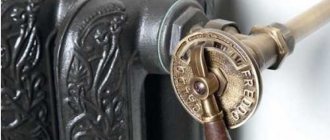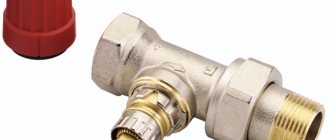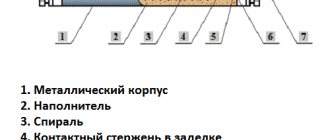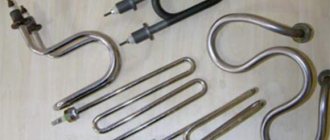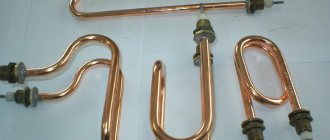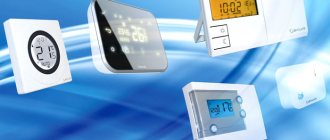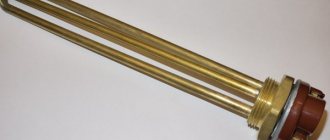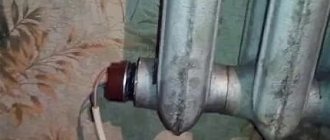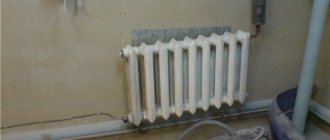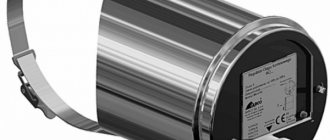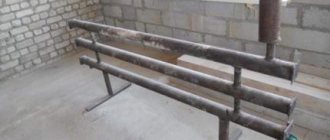In winter, the warmth in the apartment directly depends on the work of utilities. If even in severe cold the radiators in the house are barely warm, it makes sense to take heating of living spaces into your own hands. To do this, you can install a special heating element for a heating battery with a built-in thermostat. Installation of this device is simple, but it is better to take care of it before the start of the heating season. Let's figure it out in order.
Why is a heating element needed in radiators?
The device heats the coolant in the batteries and maintains its operating temperature (what temperature of water in heating radiators is considered normal?). It can be installed not only in radiators, but also in any heating devices that have cavities filled with liquid. That is why the scope of application of radiator heating elements is very wide.
The device is used mainly in small areas - garages, utility rooms, etc.
A heating element is a metal tube with a heat-conducting electrical insulator and a conductive thread.
Features of radiators equipped with a built-in heating element:
- In appearance, they are almost no different from ordinary batteries. But, unlike the latter, they are not connected to the heating system.
- The devices are filled with coolant circulating through the battery.
- The best coolant is oil with low viscosity. This prevents the radiator from freezing when it is unplugged.
Radiator heating element design
Structurally, the device differs little from other types of heating elements. Design Features:
- The body is made of metal pipe and transfers heat well. It is usually made of carbon steel or stainless steel. The latter option is chosen if the metal will be heated to temperatures above +45 °C.
- The steel tube—the body—is coated with chrome or nickel plated to protect against corrosion.
- The heating element is a nichrome spiral. This part heats up to high temperatures when an electric current passes. The spiral is located inside the housing, and the rest of the space is occupied by filler.
- The body is filled with quartz sand or periclase, and then pressure testing is carried out and the product is given the required shape.
A tube with a conductive spiral can be placed inside any radiator - copper, cast iron, bimetallic, etc. The power of the device is 2.5 kW. Industrial-type devices are more powerful - up to 6 kW.
The operation of a radiator heating element is extremely simple:
- Thanks to a well-thought-out design, all incoming electricity is converted into heat in the device, with virtually no losses.
- When turned on, the spiral heats up quickly, and the oil/water is heated from it.
- The heated liquid, in accordance with the law of physics, rises, and cold liquid comes in its place.
- The heated liquid, rising, gives off its heat and, cooling, sinks to the lower part of the radiator.
- An electrical appliance creates fluid movement inside the radiator.
The main danger of heating elements is limescale. It gradually covers the heating element, which sooner or later leads to failure.
One of the best coolant options is transformer oil. It heats up quickly and retains heat for a long time, gradually releasing it to the body.
Advantages and disadvantages of radiator heating elements
Tubular electric heaters allow you to organize a practical and highly efficient heating system - main or additional. Before buying the necessary equipment, it is useful to evaluate all its advantages and disadvantages.
Pros:
- Simple installation - even an inexperienced technician can handle it.
- Low price of the heating element (not counting other equipment).
- Much more reliable than oil radiators. Batteries with heating elements are subject to repair. When the equipment fails, it is enough to replace the heating element.
- There is additional functionality.
- Automatic control of the heating system is possible - however, for this you will have to purchase additional appropriate equipment.
Minuses:
- High operating costs - this disadvantage is due to high electricity tariffs.
- Automation comes at a cost. If you buy a heating element with automation, the price of this kit will cost much more than an electric convector.
- They are inferior to oil radiators and convectors in terms of comfort due to lack of mobility.
- Heating elements are electrical appliances, and therefore generators of electromagnetic fields. The harmful effects of the device have not been proven. But field generation is a negative fact, given the proximity of the installation of radiators to the location of people. Due to the high speed of fluid movement, the device is inferior in efficiency to conventional systems with liquid coolants.
Costs will decrease if you switch the heating system control to automatic mode. Thanks to automation, heating elements will start working only after the temperature drops to a certain level. When the coolant heats up to the set value, the device will automatically turn off.
Criterias of choice
When selecting a heating element for a radiator, you should take into account its technical characteristics, as well as the parameters of the battery. The main factors influencing the choice of device are:
- Power. In rooms with good thermal insulation properties, heaters from 2 to 3 kilowatts can be installed. In older buildings, it is best to use heating elements with higher power.
- Length of the electric heating tube. It is recommended to purchase heating elements ten centimeters shorter than the battery. Correct selection of the length of the heating device allows you to evenly heat all sections of the radiator.
- Battery Type. In order for the heating element to optimally fit the radiator, you should carefully study its technical data sheet. It specifies which types of batteries the product should be used with.
- Automatic control. Not all models have this option. For ease of use, it is best to purchase heating elements with automation, which are equipped with a thermostat.
The heating element should be ten centimeters shorter than the radiator.
The diameter of the electric heater is also taken into account in accordance with the cross-section of the plug on the radiator. It is important to correctly determine the placement of the thread.
It is necessary to purchase only high-quality heating elements from trusted manufacturers. Before purchasing an electrical appliance, you should check its integrity and serviceability.
Types of heating elements for radiators
Despite the structural simplicity, various options for heating elements for radiators are presented on the shelves of specialized retail outlets and online stores. They differ in body design, materials of manufacture, power, and other features.
How to install heating elements in a battery, let’s compare heating elements. Homemade electric heating without pipes.
How heating elements for radiators differ:
- By power. Low-power models are designed for 0.3 kW. Devices up to 4 kW belong to the household category, from 4 to 6 kW - to the industrial category.
- Constructively. Manufacturers produce heating elements with right and left threads, single and double. The latter are considered more convenient to use. They increase the heating rate of the coolant, but are more expensive.
- Diameters. It depends on the cross-section of the radiator plugs on which the devices are mounted. The standard value is 40 mm.
- Additional options. The manufacturer offers 2 functions: Turbo heating. This is a mode that allows you to rapidly increase the temperature of the coolant to quickly heat the room. If this function is available, the device is equipped with a thermostat that allows you to change the room heating modes.
- Antifreeze. A mode that prevents system breakdown (defrosting) when temperatures drop. Heating elements with this function automatically maintain the minimum temperature due to economical energy consumption.
Also, heating elements for radiators may differ in length and have different design characteristics, which are not decisive for obtaining the result.
How are heating elements used in heating radiators?
The main function of heating elements for radiators is to heat the liquid in heating systems, centralized or autonomous. The device can be used as a primary or secondary source.
Options for using radiator heating elements in heating systems:
- In temporary housing. In the off-season, while the heating has not yet started working, such radiators warm the residents. Radiator heating elements are convenient in country houses that have to be heated from time to time. In this case, heating elements are installed in radiators installed in each room. In rooms that do not have any other type of heating, heating elements in radiators are used autonomously as the only source of heat. In this case, it is recommended to fill the batteries with oil with a low viscosity level, since it has a low freezing point.
- In permanent housing. The batteries are filled with ordinary water (this is cheaper), since the system is not expected to freeze. But this option is expensive, since you have to constantly waste electricity. Heating elements in radiators can be installed in high-rise buildings if the main heating system does not provide comfort in the room. Installing these devices allows you to maintain optimal temperature in residential areas.
- Addition. This is the most rational and popular option. Heating elements are built into batteries and are turned on when the heating is turned off for one reason or another.
Installing radiator heating elements in multi-storey buildings is an unprofitable and impractical solution, since it involves limiting the access of water circulating through the heating system in the house. As a result, you have to pay twice - for the operation of the electric heating element and for the central heating.
Electric boiler
A boiler powered by electricity is used much more actively than the type of heating described above. It is also capable of heating the room evenly using radiators connected to it.
The positive properties of an electric boiler are as follows:
- there is the ability to control the temperature level;
- practical equipment with low cost;
- it takes a little time to fully heat the room;
- The period of operation of an electric boiler is not limited.
How to choose?
Radiator heating elements are not so diverse as to create special difficulties when choosing. The main thing that people pay attention to when buying is power and design features.
Battery heating element for an aluminum radiator with a GREPAN temperature sensor and its characteristics.
Power calculation formula
To correctly calculate power, local standards of thermal performance indicators are needed (they are different for each region). But, in principle, you can also use the average indicator valid for central Russia.
Let the heater be the main heating in the house/room. For this case, you need a model with a thermostat. We take into account that for heating 10 sq. m is 1 kW. Devices used for emergency heating use 3-4 times less power.
The heat output of the radiator is specified by the manufacturer. At the same time, the average rating of one battery section made of cast iron is 140 W, and of aluminum - 180 W.
Heating without pipes, how to calculate the power of a heating element for a battery
Calculation formula for heating element power: Q = 0.0011*M (T1-T2)/t, where:
- M is the mass of the energy carrier;
- T1—temperature after heating;
- T2—temperature before heating;
- t is the time for maximum temperature increase.
Design Features
When choosing a heating element, its dimensions and thread direction are taken into account. The length of the rod, in particular, directly affects the efficiency. If the heating element is not long enough, the equipment will not be able to provide the required fluid speed. Because of this, the radiator will not heat up enough and unevenly.
The optimal length is considered to be at which the rod of the device does not reach the inner wall of the opposite side of the radiator by 6-10 cm. When choosing the shape and material of the plug, take into account the recommendations from the manufacturer - suitable options are usually indicated there.
Automatic control
When buying a radiator heating element, pay attention to whether it has automatic control . If yes, then you get the most convenient device that does not require the cost of purchasing additional accessories.
The self-controlled heating element is equipped with a thermostat built into the lower part of its body. It has a special sensor that measures the temperature of the liquid. Based on its readings, the heating element automatically turns on and off, saving energy.
In heating elements without automation there is no thermostat. Then it is recommended to connect it by installing a detector in the room to measure the air temperature in the room. This is an impractical and inconvenient option today; European manufacturers do not produce such devices.
Product types
Electric heating elements differ in:
- type of work environment. There are models for heating gas (air) and liquid;
- type of working surface. They can be tape, rod, ribbed, tubular;
- method of use. There are products designed for installation in radiators, boilers, boilers and other equipment;
- technical specifications. The power per unit surface is taken into account;
- functionality. There are models with a thermostat and automatic shutdown sensors when overheating.
Installation of heating elements
There is nothing complicated about installing radiator heating elements, so any home craftsman can do it. To avoid any problems during installation, before purchasing, familiarize yourself with its packaging and check that everything is in place.
It is advisable that the box contains everything necessary for installation along with the heating element. If any parts are missing, you need to purchase them immediately. The installation of heating elements with thermostats is practically no different from the installation of analogues without automatic control.
Before installing the heating element into the radiator, make sure that the heating system is drained of water. That is why in apartment buildings it is better to install the device in the summer, when the central heating is turned off.
How to install the heating element:
- Remove the plug located at the bottom of the radiator.
- Install the heating element using a threaded fastener and a rubber gasket.
- Treat the joint with sealant.
Video of installation of radiator heating element:
Radiator with heating element. We do it ourselves.
Autonomous heating, heating element in the battery, in case of emergency heating shutdown
What to pay attention to:
- Place the heating element only in the lower part of the radiator - this will ensure unhindered coolant circulation.
- The device is inserted into the battery strictly parallel to the floor - this is necessary for unhindered operation.
- The coolant, when heated, increases the pressure in the battery. This requires the installation of a small expansion tank. You can also equip the radiator with a valve to regulate the pressure in the system.
- The heating element can only be connected through a grounded socket. It is also recommended to connect the device to a voltage stabilizer - this will protect it from power surges.
- The fasteners for connections of tubular electric heaters are quite fragile. In order not to damage it, installation must be done with the utmost care, without applying unnecessary force.
When are heaters needed?
As a rule, the device is purchased to create local autonomous heating or as an addition to a central heating system. If the latter is unstable, heating elements often become an “emergency” heater of the coolant inside the batteries.
If for some reason the central heating is turned off, using the heating element it will be possible to maintain the temperature in the house at the required level and avoid defrosting of the pipes.
Safety issues and operating features
The tubular electric heater operates on mains power, which means it poses a certain danger if you do not follow a number of safety rules.
Recommendations for use and safety precautions:
- The radiator heating element will work for a long time and without breakdowns, in accordance with its technical parameters, if it is serviced every 3 months. The device is cleaned of scale that forms on its surface - this is necessary to ensure normal heat transfer. If the heater is not descaled in time, it may fail.
- Do not allow the electric heater to overheat. It is unacceptable to exceed the maximum temperature - +70 °C.
- The heating element can only be turned on in a radiator filled with coolant. If water gets on a hot appliance, a thermal explosion may occur. As a result, not only the battery will be damaged, but also the entire heating system.
- If static electricity appears on the surface of tubular heaters, immediately disconnect the device from the power supply and check all connections for leaks.
- The power of the heating element cannot exceed the thermal rated power of the radiator. There can be no more than 3.5 kW per outlet.
- If a heating element is installed in a radiator, it is necessary to provide reliable and proper grounding.
To reduce the intensity of scale formation on the radiator heating element, it is recommended to use distilled water as a coolant.
